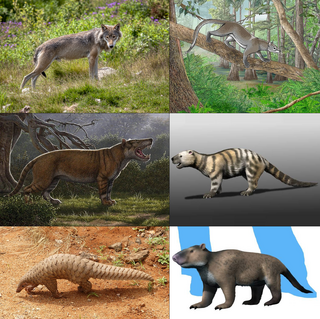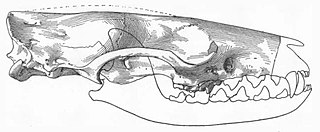
Taeniolabis is a genus of extinct multituberculate mammal from the Paleocene of North America.

Purgatorius is a genus of seven extinct eutherian species typically believed to be the earliest example of a primate or a proto-primate, a primatomorph precursor to the Plesiadapiformes, dating to as old as 66 million years ago. The first remains were reported in 1965, from what is now eastern Montana's Tullock Formation, specifically at Purgatory Hill in deposits believed to be about 63 million years old, and at Harbicht Hill in the lower Paleocene section of the Hell Creek Formation. Both locations are in McCone County, Montana.

Ferae is a mirorder of placental mammals from grandorder Ferungulata, that groups together clades Pan-Carnivora, which includes modern carnivorans, and Pholidotamorpha, which includes pangolins.

South American native ungulates, commonly abbreviated as SANUs, are extinct ungulate-like mammals of controversial affinities that were indigenous to South America prior to the Great American Biotic Interchange. They comprise five major groups conventionally ranked as orders—Astrapotheria, Litopterna, Notoungulata, Pyrotheria, and Xenungulata—as well as the primitive "condylarth" groups Didolodontidae and Kollpaniinae. It has been proposed that some or all of the members of this group form a clade, named Meridiungulata, though the relationships of South American ungulates remain largely unresolved. The two largest groups of South American ungulates, the notoungulates and the litopterns, were the only groups to persist beyond the mid Miocene. Only a few of the largest species of notoungulates and litopterns survived until the end-Pleistocene extinction event around 12,000 years ago where they became extinct with most other large mammals in the Americas, shortly after the first arrival of humans into the region.

Miacis is an extinct genus of placental mammals from clade Carnivoraformes, that lived in North America from the early to middle Eocene.

Protungulatum is an extinct genus of eutherian mammals within extinct family Protungulatidae, and is possibly one of the earliest known placental mammals in the fossil record, that lived in North America from the Late Cretaceous to early Paleocene.

Triisodontidae is an extinct, probably paraphyletic, or possibly invalid family of mesonychian placental mammals. Most triisodontid genera lived during the Paleocene in North America, but the genus Andrewsarchus is known from the middle Eocene of Asia. Triisodontids were the first relatively large predatory mammals to appear in North America following the extinction of the non-bird dinosaurs. They differ from other mesonychian families in having less highly modified teeth.

The Fort Union Formation is a geologic unit containing sandstones, shales, and coal beds in Wyoming, Montana, and parts of adjacent states. In the Powder River Basin, it contains important economic deposits of coal, uranium, and coalbed methane.

Vassacyon is an extinct genus of placental mammals from clade Carnivoraformes, that lived in North America and Europe from the late Paleocene to early Eocene. It is considered the largest of the early Eocene mammals.

Didymictis is an extinct genus of placental mammals from extinct subfamily Didymictinae within extinct family Viverravidae, that lived in North America and Europe from the late Paleocene to middle Eocene.
The Paleocene, or Palaeocene, is a geological epoch that lasted from about 66 to 56 million years ago (mya). It is the first epoch of the Paleogene Period in the modern Cenozoic Era. The name is a combination of the Ancient Greek παλαιός palaiós meaning "old" and the Eocene Epoch, translating to "the old part of the Eocene".

Leptictida is a possibly paraphyletic extinct order of eutherian mammals. Their classification is contentious: according to cladistic studies, they may be (distantly) related to Euarchontoglires, although they are more recently regarded as the first branch to split from basal eutherians. One recent large-scale cladistic analysis of eutherian mammals favored lepictidans as close to the placental crown-clade; and several other recent analyses that included data from Cretaceous non-eutherian mammals found Leptictis to belong to the superorder Afrotheria.
The Willwood Formation is a sedimentary sequence deposited during the late Paleocene to early Eocene, or Clarkforkian, Wasatchian and Bridgerian in the NALMA classification.
This paleomammalogy list records new fossil mammal taxa that were described during the year 2011, as well as notes other significant paleomammalogy discoveries and events which occurred during that year.
This paleomammalogy list records new fossil mammal taxa that were described during the year 2010, as well as notes other significant paleomammalogy discoveries and events which occurred during that year.

Viverravus is an extinct genus of placental mammals from extinct subfamily Viverravinae within extinct family Viverravidae, that lived in North America, Europe and Asia from the middle Paleocene to middle Eocene.
This paleomammology list records new fossil mammal taxa that were described during the year 2021, as well as notes other significant paleomammology discoveries and events which occurred during 2021.
This paleomammalogy list records new fossil mammal taxa that were described during the year 2015, as well as notes other significant paleomammalogy discoveries and events which occurred during that year.

Palaeonictinae is an extinct subfamily of placental mammals from extinct family Oxyaenidae, that lived from the late Paleocene to early Eocene of Europe and North America.

The Salamanca Formation is a geologic formation in the Golfo San Jorge Basin of central Patagonia that yields well-preserved, well-dated fossils from the early Paleocene. Studies of these fossils are providing new data on plant and animal diversity following the end-Cretaceous extinction event.

















